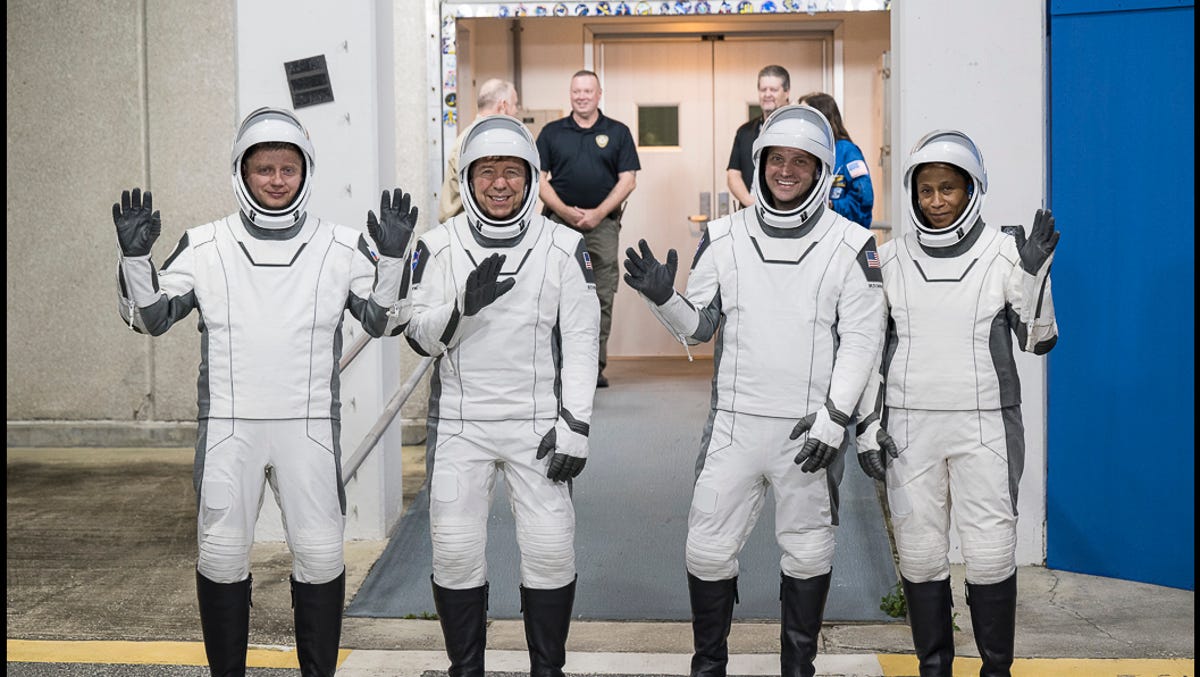Update 7:41 a.m. Thursday: Overnight, NASA officials postponed the Crew-8 mission to 11:16 p.m. Saturday, citing high winds and waves along the Dragon spacecraft’s flight track.
Original story: NASA’s SpaceX Crew-8 stands poised to launch on its six-month mission to the International Space Station, extending an ongoing low-Earth-orbit legacy that remains underestimated by many Americans.
“When you take a step back and you think about the International Space Station, for anyone under the age of 23 they have not known a time in their life when they have not had humans on orbit 24 hours a day, seven days a week,” NASA Deputy Associate Administrator Casey Swails said last month during a SpaceCom ballroom speech in Orlando.
“Which is truly, truly incredible,” Swails said.
Crew-8’s liftoff is targeted for 12:04 a.m. EST Friday aboard a SpaceX Falcon 9 rocket and Dragon Endeavour capsule from pad 39A at NASA’s Kennedy Space Center. The Falcon 9 will ascend in a northeasterly trajectory. If needed, a backup launch opportunity is available at 11:41 p.m. Friday, SpaceX announced.
After stage separation, the rocket’s first-stage booster will target landing at Cape Canaveral Space Force Station 7 minutes, 38 seconds after liftoff, generating sonic booms in Brevard County.
FLORIDA TODAY’s Space Team will link to NASA TV coverage and provide mission updates starting about 8 p.m. Thursday at floridatoday.com/space.
After reaching orbit, Endeavour should dock with the forward part of the ISS about 7 a.m. Saturday, Joel Montalbano, NASA’s International Space Station Program manager, said during a Wednesday press conference. After about two hours of leak checks, the hatch should open.
“The Crew-8/Crew-7 handover will take about five days. We’ll have five days of handover activities, after which we’ll start watching weather and look for a landing opportunity for Crew-7. Crew-8 will stay on board the International Space Station until late August,” Montalbano said.
Crew-8 marks NASA’s eighth crew rotation mission with SpaceX to the ISS as part of the agency’s Commercial Crew Program.
“This mission to the ISS really has a lot of exciting science that they’re doing. There are some 200 science experiments. And a lot of the stuff dreamed of in the old days is just coming to fruition: the use of protein crystal growth, the medical research into the use of and growing stem cells in microgravity,” NASA Administrator Bill Nelson said.
Nelson said this research will also study the brain and focus on finding cures for cancer and bone loss.
Crew-8 members:
- NASA astronaut Matthew Dominick, commander.
- NASA astronaut Michael Barratt, pilot.
- NASA astronaut Jeanette Epps, mission specialist.
- Roscosmos cosmonaut Alexander Grebenkin, mission specialist.
The Space Force’s 45th Weather Squadron now pegs the odds of “go for launch” conditions at 85%, down from 90%. Liftoff winds and isolated showers pose the primary weather concerns at Cape Canaveral.
However, meteorologists continue carefully monitoring the mission’s “abort weather” along the Falcon 9’s East Coast trajectory path in case the capsule ejects during a launch anomaly, said Steve Stich, NASA’s Commercial Crew Program manager. The squadron’s latest forecast now shows a moderate-to-high risk of poor ascent corridor weather.
Stich said crews are watching wave and sea conditions, wind, rainfall and lightning forecasts across about 60 geographic points.
During a second NASA press conference Wednesday, Jennifer Buchli, International Space Station Program chief scientist, said Endeavour will carry up more than 350 pounds of science-related cargo. That will add to the 3,017 pounds lifted to the ISS during last month’s NG-20 cargo mission, where a Falcon 9 rocket lofted its first Northrop Grumman Cygnus spacecraft to the orbiting outpost.
“We have opened up the aperture, as far as R&D is concerned,” said Patrick O’Neill, ISS National Laboratory public affairs and outreach lead.
“So, Fortune 500 companies. Innovative startups. Academia. Nonprofits. Other government agencies like the NIH, the NSF. All of them are leveraging this space-based environment to bring value to life back here on Earth, as well as to develop a robust and sustainable economy in low-Earth orbit,” O’Neill said.
For the latest news from Cape Canaveral Space Force Station and NASA’s Kennedy Space Center, visit floridatoday.com/space.
Rick Neale is a Space Reporter at FLORIDA TODAY (for more of his stories, click here.) Contact Neale at 321-242-3638 or [email protected]. Twitter/X: @RickNeale1

Dr. Sarah Adams is a scientist and science communicator who makes complex topics accessible to all. Her articles explore breakthroughs in various scientific disciplines, from space exploration to cutting-edge research.







